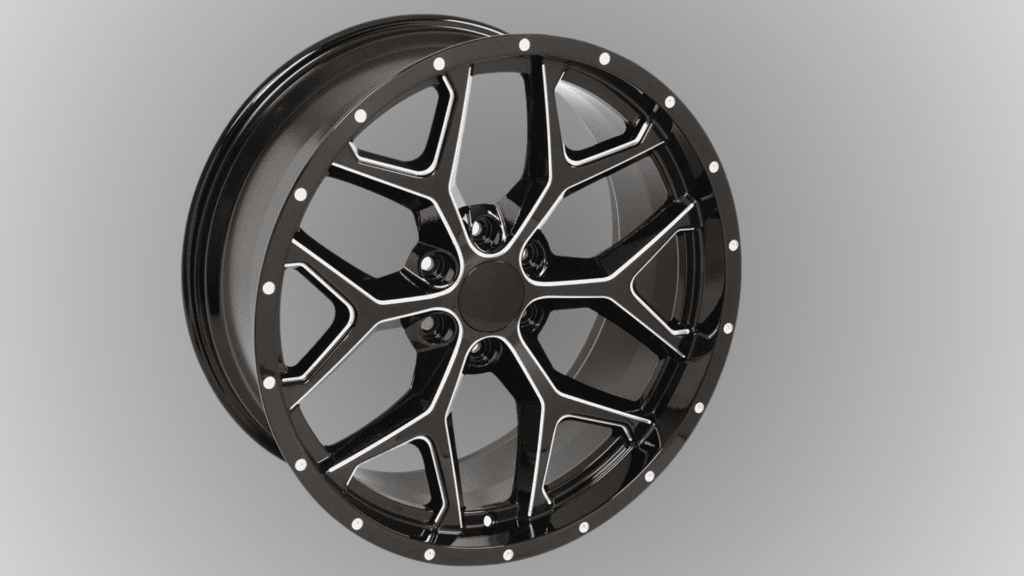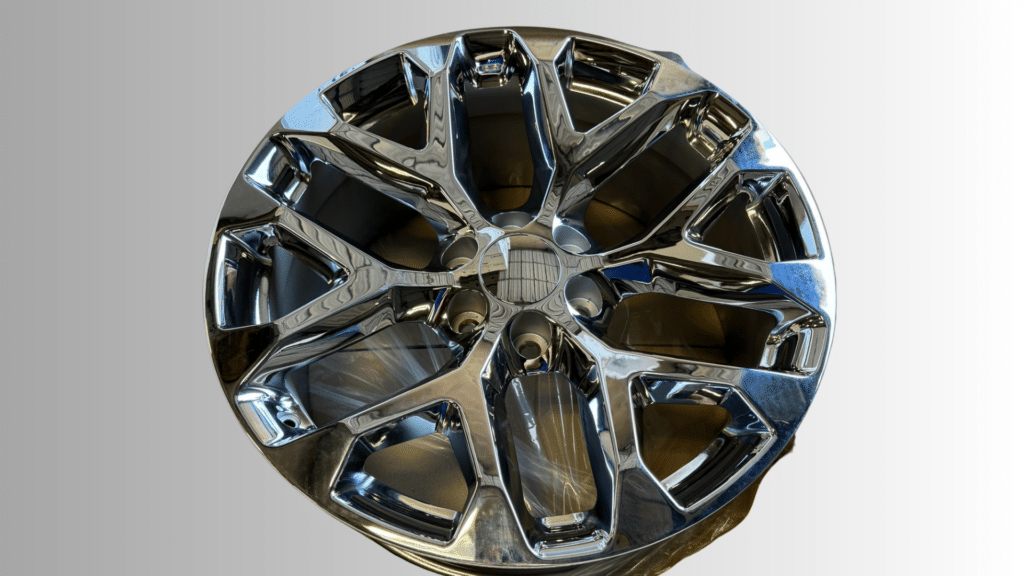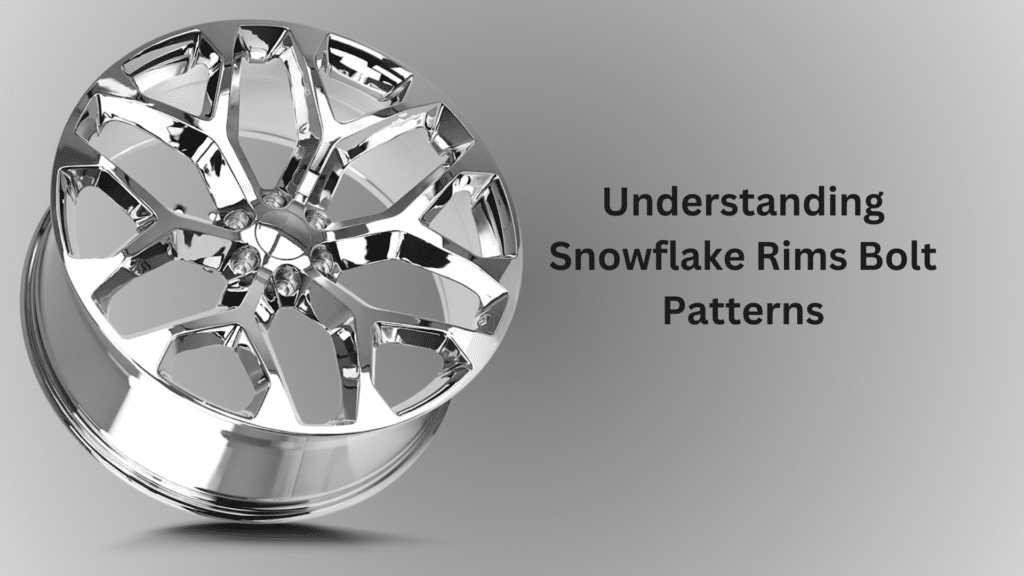Ever noticed those distinctive VW Snowflake wheels from the GTI and wondered about getting a set for your car?
Before you start hunting for these classic rims, there’s one crucial detail you need to get right: the bolt pattern.
These iconic wheels, first seen on the MK2 Golf GTI, have become a sought-after upgrade for many car enthusiasts.
But here’s the thing – installing the wrong bolt pattern can leave you with expensive paperweights instead of sweet new rims.
In this guide, we’ll walk you through everything you need to know about Snowflake rim bolt patterns.
You’ll learn how to measure them correctly, understand which cars they fit, and avoid common mounting mistakes.
Whether you’re planning to buy a set or just curious about these classic wheels, we’ll help you make sense of the technical stuff without the confusion.
What is the Bolt Pattern for Snowflake Rims?

Let me break down bolt patterns in a way that’ll actually make sense. When I’m working on wheels, I think of bolt patterns as a wheel’s “fingerprint” – it’s simply how many bolts hold your wheel to the car and how they’re spaced out.
Understanding the Numbers
The bolt pattern on Snowflake rims comes in two key measurements: 4×100and 5×100. Here’s what these numbers mean in plain English:
- The first number (4 or 5) tells you how many lug holes the wheel has
- The second number (100) shows the diameter in millimeters of the circle these holes make
I’ve seen both patterns on original Snowflake rims, depending on which VW model they came from. The 4×100 pattern was common on earlier GTIs, while 5×100 showed up on later models.
Most people don’t realize that when you’re measuring the bolt circle on a 4-lug wheel, you measure straight across from one hole to another.
But on a 5-lug wheel, you need to measure from the center of one hole to the outer edge of the hole across from it. I learned this the hard way after years of working with different wheel setups.
But don’t just take my word for it – you’ll want to measure your car’s bolt pattern to be absolutely sure.
Trust me, I’ve seen too many folks rush into buying wheels without checking, only to end up with rims that won’t fit their car.
Understanding Snowflake Rims Bolt Patterns and Their Compatibility
What I’ve learned about matching Snowflake rims to different cars. After years of helping people with wheel fitments, I’ve noticed some key patterns that’ll save you time and money.
The original Snowflake rims came on different VW models, and here’s what makes this interesting: early models (like the MK2 GTI) used a 4×100 pattern, while later ones switched to 5×100.
You might find some rare 5×112 versions out there, but these aren’t the original equipment ones.
Key Factors That Affect Compatibility
Beyond just counting bolt holes, here’s what you need to check:
- Center Bore Size: VW Snowflakes typically have a 57.1mm center bore. If your car’s hub is smaller, you’re good with hub-centric rings. If it’s larger, these rims won’t center properly.
- Offset (ET): Most Snowflakes have an ET35 offset. This affects how the wheel sits in your wheel well – too far in or out can cause rubbing.
- Load Rating: These wheels were designed for relatively light cars. I always check if they can handle your vehicle’s weight.
Ensuring a Proper Fit for Your Vehicle
Look, I know the temptation to just bolt these wheels on and hope for the best. But here’s my process for getting it right:
First, measure your current setup – hub diameter, offset, and bolt pattern. Then, compare these numbers with the Snowflake specs. If something’s off, determine if spacers or adapters are a safe option.
Remember that wheel adapters change your final offset. From my experience, going beyond 25mm adapter thickness usually causes more problems than it’s worth.
One thing that often surprises people: even if the bolt pattern matches perfectly, factors like brake caliper clearance can still make these wheels incompatible with your car.
I always recommend doing a test fit if possible before making any permanent changes.
How to Identify the Correct Bolt Pattern for a Specific Snowflake Rims Model?
Using Manufacturer Guides or Manuals
When I’m checking specs, I start with the wheel’s manufacturing marks. Look for these key markings on the back of the wheel:
- The ET number (offset)
- Size markings (like 14×6)
- A production date code
- VW part numbers starting with “321” or “191”
These numbers tell you if you’re looking at genuine VW Snowflakes and help track down the correct bolt pattern through official guides.
Measuring the Bolt Pattern Accurately
My foolproof method for measuring bolt patterns:
For 4-lug patterns:
- Measure from the center of one bolt hole to the center of the opposite hole
- If it measures 100mm, you’ve got a 4×100 pattern
For 5-lug patterns:
- Measure from the center of any bolt hole to the outer edge of the hole two spots over
- Multiply this number by 1.701 to get your bolt circle diameter
- A result close to 100mm confirms a 5×100 pattern
Tips for Identifying Patterns on Used or Aftermarket Rims
When I’m checking used Snowflakes, I watch out for these things:
Look for signs of adapter use – enlarged bolt holes or unusual wear patterns often mean someone modified the original bolt pattern.
Check the barrel of the wheel for any stamped numbers indicating a replica manufacturer.
One trick I use: place the wheel flat on the ground and drop a straight edge across two bolt holes. If it’s not perfectly level on a 4-lug wheel, something’s off with the pattern.
Remember, measuring twice now saves replacing parts later. If you’re still unsure, I always recommend having a professional wheel shop verify the measurements.
They have specialized tools that can confirm these numbers with absolute certainty.
How to Maintain Bolt Patterns on Your Snowflake Rims?

Proper Cleaning and Care for Rims
Start with the basics – keeping your bolt holes clean is crucial. Here’s my method:
Never use harsh chemicals around the lug holes. I’ve seen too many people damage the metal this way. Instead, use a mild soap solution and a soft brush to clean:
- Inside each lug hole
- Around the mounting surface
- Behind the wheel where crud builds up
After washing, I always dry the holes thoroughly. Water sitting in there is your worst enemy – trust me, I’ve seen what happens when it’s left to sit.
Avoiding Rust and Corrosion on Lug Nuts and Studs
Something many people miss: rust prevention isn’t just about the visible parts. When I’m working on wheels, I:
- Apply a thin coat of anti-seize compound on the studs (not the threads!)
- Use stainless steel lug nuts when possible
- Keep a set of spare lug nuts handy – they’re cheap insurance
Remember to hand-thread lug nuts first. I’ve seen stripped threads too many times from people going straight in with the impact wrench.
Checking Alignment and Fit Regularly
This is where my experience really comes in handy. Every few months, I check for:
- Elongated bolt holes – this means something’s loose
- Uneven wear around the lug holes
- Any wobble in the wheel’s mounting surface
Here’s a pro tip: mark your lug nuts with a paint dot after torquing them properly. If the marks move, you know something’s loose before it becomes a problem.
And don’t forget – retrieve your wheels after the first 50 miles of installing them. I’ve caught many potential issues early this way.
Last but crucial: if you hear any new noises or feel vibrations, check your wheel fitment immediately. Better to catch problems early than deal with damaged bolt patterns later.
List of the Correct Bolt Pattern for Different Snowflake Rim Models
A comprehensive breakdown of Snowflake rim bolt patterns based on my experience working with different models:
| Model Type | Bolt Pattern | Center Bore | Common Applications | Notes |
|---|---|---|---|---|
| Standard 5-Lug | 5x100mm | 57.1mm | VW Golf GTI MK3/4<br>VW Jetta III/IV<br>Audi TT MK1 | The most common pattern for later-model Snowflakes |
| Early 4-Lug | 4x100mm | 57.1mm | VW Golf GTI MK2<br>Early Jetta Models | Original pattern for classic Snowflakes |
| Euro-Spec 5-Lug | 5x112mm | 57.1mm | European VW Models<br>Some Audi Applications | Rare variant, typically the European market |
| Custom/Replica 5-Lug | 5×114.3mm | 73.1mm | Aftermarket Versions<br>Modified Fitments | Not original VW specs |
| Custom/Replica 4-Lug | 4x108mm | 63.4mm | Custom Applications<br>Ford Fitments | Aftermarket adaptations |
| Modern Reproductions | 5x100mm | 57.1mm | Modern VW/Audi<br>Subaru Models | Current production specs |
Important Notes:
- There were no original 6-lug Snowflake rims from VW
- Custom and specialty patterns are typically aftermarket modifications
- Adapter use may affect final fitment and safety
- Always verify measurements before purchase
Remember: These specifications are for genuine and common reproduction Snowflake rims. Custom or modified versions might have different specifications.
Comparisons Between Snowflake Rims and Other Brands’ Bolt Patterns with Prices
After comparing countless wheel setups, here’s my detailed breakdown of how Snowflake rims stack up against popular alternatives:
| Wheel Type | Bolt Pattern | Average Price (per wheel) | Compatibility | Build Quality | Style Notes |
|---|---|---|---|---|---|
| Original VW Snowflakes | 4×100, 5×100 | $200-350 | VW/Audi | High | Classic OEM design |
| BBS RS | 5×100, 5×112 | $600-800 | Universal | Premium | Split-rim design |
| Enkei RPF1 | 4×100, 5×100 | $250-350 | Multiple | Very Good | Lightweight racing |
| Rota Grid | 4×100, 5×100 | $150-200 | Universal | Good | Modern mesh style |
| ESM 004(Snowflake Replica) | 5×100, 5×112 | $160-200 | Multiple | Moderate | Direct replica |
| Schmidt TH-Line | 5×100, 5×112 | $400-500 | European | Premium | Similar aesthetic |
Notable Market Comparisons:
- Original Snowflakes: Best value for authenticity
- Modern Replicas: 40-60% cheaper but variable quality
- Premium Alternatives: Usually 2-3x more expensive
Popular Alternatives Worth Considering:
- For Budget Builds ($150-200/wheel):
- Rota Grid
- XXR 522
- ESM Replicas
- For Premium Upgrades ($400-600/wheel):
- Work Emotion CR Kai
- OZ Racing Superturismo
- BBS CH
- For OEM+ Builds ($250-350/wheel):
- BBS RZ
- Fifteen52 Formula GT
- Neuspeed RSe
Remember: These prices reflect market conditions as of early 2024. Always factor in additional costs for:
- Proper mounting hardware
- Center rings if needed
- Professional installation
- Tire costs
I’ve found that investing in quality wheels usually saves money long-term, especially with classic styles like Snowflakes.
Conclusion
After working with Snowflake rims for years, here’s what really matters: getting the bolt pattern right is crucial for both safety and performance.
Whether you’re going with original 4×100 or later 5×100 patterns, double-check your measurements before buying.
Remember these key points:
- Always measure your car’s bolt pattern twice
- Consider your budget – authentic Snowflakes cost more but last longer
- Keep your mounting surfaces clean and properly torqued
- Don’t skip regular maintenance checks
If you’re still unsure about fitment, talk to a trusted wheel shop. They can help verify your measurements and catch potential issues before they become problems.
While Snowflake rims might cost more than some alternatives, their classic design and proven durability make them worth the investment when properly maintained.
Just take your time and do your homework, and you’ll end up with a setup that looks great and performs even better.
Frequently Asked Questions
How Do I Know if My Car Will Fit VW Snowflake Rims?
Your car needs to have either a 4×100 or 5×100 bolt pattern to fit the original Snowflakes. Measure your current wheels’ bolt pattern and center bore (ideally 57.1mm), and check brake caliper clearance.
If your measurements don’t match, adapters might work, but they can affect handling and safety.
What’s the Best Way to Check if Snowflake Rims Are Original?
Look for VW part numbers starting with “321” or “191” cast into the back of the wheel. Original Snowflakes also have specific manufacturing marks and date codes. The finish quality is typically higher than replicas, with even spacing between spokes and consistent casting marks.
Why Are Some Snowflake Rims More Expensive Than Others?
Original VW Snowflakes cost more because they’re genuine OEM parts with proven quality and becoming rarer. Prices range from $200-350 per wheel for originals, while replicas run $160-200. The difference is in the materials, finish quality, and long-term durability.
What Tools Do I Need to Measure Bolt Patterns Correctly?
You’ll need a good quality caliper or bolt pattern gauge, a straight edge, and ideally, a center bore gauge. Digital calipers work best for accurate measurements. Remember, measuring 5-lug patterns requires a different technique than 4-lug patterns.
Can I Convert My Car’s Bolt Pattern to Fit Snowflake Rims?
While adapters exist, I recommend staying within 25mm thickness for safety. Larger adapters can stress wheel bearings and affect handling. Consider the total cost of adapters, longer lug bolts, and professional installation before choosing this route.


